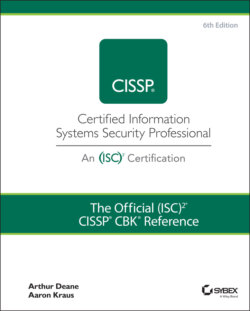Читать книгу The Official (ISC)2 CISSP CBK Reference - Leslie Fife, Aaron Kraus - Страница 93
Administrative
ОглавлениеWhen discussing investigations, for (ISC)2 purposes, the term administrative will refer to actions constrained to those conducted within a single organization — that is, the organization performs an administrative investigation of itself. Internal investigations are typically performed when the matter involves some violation of organizational policy and does not involve any external entities such as law enforcement, investors, third-party suppliers, or attackers.
NOTE To avoid confusion, it is important to distinguish how the term administrative is used in a variety of ways to avoid confusion. For (ISC)2, it means an internal investigation. In the United States, administrative law refers to a set of laws made by regulatory bodies (such as the Drug Enforcement Agency, the Food and Drug Administration, and the like). For the purposes of the CISSP Body of Knowledge, an administrative investigation will only refer to an internal investigation.
The organization itself can task anyone to perform activities for administrative investigations. This can include staff and employees within the organization (physical and IT security personnel, auditors, management, etc.) or might involve specialized contractors hired by the organization to perform investigative tasks.
The burden of proof for administrative investigations is the lowest of all investigation types. Management can use whatever criteria they choose to believe evidence.
Punitive measures that may result from administrative investigations include employee termination, loss of privilege, reassignment, and so forth. Management might also choose to change the type of investigation as a result of findings made during the administrative investigation; if the administrative investigation reveals that the parties involved engaged in intentional/malicious or criminal activity, management may escalate to civil actions (lawsuits) or filing criminal charges, both of which would require investigatory actions relevant to those situations.
Despite the low burden of proof required for management to act in an administrative investigation, care should still be taken during the process. Occasionally, evidence gathered during an administrative investigation may lead to or be used in a civil or criminal investigation, as stated earlier. If evidence is mishandled during an administrative investigation, it may compromise the ability to use that evidence in later proceedings. If there is any uncertainty about whether an administrative investigation may ultimately escalate, a discussion of this concern with management or in-house or outside counsel is prudent.
Consider this example of an investigation: The IT department contacts the security office to make a report of an employee misusing the organization's internet connection to engage in unauthorized file sharing, in direct violation of the organization's policy. The security office makes the situation known to management; management instructs the IT and security departments to gather information about the user's online activity. Personnel in the IT and security departments work together to gather log data about the user's account and machine, and they present this information to management. Management consults with the legal and human resources departments to evaluate courses of action. Management decides to terminate the employee.
This is strictly an administrative investigation.
